Estimation of Soil-Related Parameters Using Airborne-Based Hyperspectral Imagery and Ground Data in the Fenwei Plain, China
Abstract
1. Introduction
- During the airborne-based hyperspectral imaging, in situ soil sampling, ground-based reflectance measurements, and radiometric calibration processes were conducted in typical mining areas in the FWP region.
- Soil hyperspectral reflectance libraries and HM concentrations were created based on airborne–ground simultaneous and integrated observations of 100 in situ soil samples, which fill the data gap in simultaneous airborne–ground measurements of eight soil-related parameters.
- Four hundred and twenty-eight bands of five optimal wavelength ranges with high-quality and obvious spectral characteristics were selected, and eight training data subsets were generated after the data preprocessing steps, including spectral resampling, envelope, and soil sample pruning processes.
- Soil-related parameter retrieval models based on three ML methods were built to boost the optimization of the retrieval model by quantifying the RMSE of each training and testing data subset.
- The concentrations of eight HMs obtained using the proposed retrieval model were estimated and mapped in mining areas for real applications.
2. Materials and Methods
2.1. Study Area
2.2. Field Measurements
2.2.1. Airborne- and Ground-Based Instruments
2.2.2. Airborne- and Ground-Based Measurements
2.2.3. Soil Sampling Points and Related Parameters
2.3. Methods
2.3.1. Methodology Overview
- Step 1: Airborne-based hyperspectral imagery, ASD soil reflectance, and soil-related HM concentrations were collected and measured as original data, described in detail in Section 2.2.
- Step 2: Data preprocessing includes both airborne-based imagery and ground-based field observations. Geometric corrections, radiometric calibration, atmospheric correction, and region of interest (ROI) extraction were conducted using airborne-based imagery. The data pruning process was performed on the ground-based soil samples.
- Step 3: Select high-quality and soil-related parameter response characteristics wavelengths from ground-based ASD and airborne-based spectral reflectance. The soil-related parameter modeling process is based on ML methods using the 428 hyperspectral wavelength selection results.
- Step 4: Evaluation metrics were used to estimate the accuracy between predicted HM concentrations and ground truth in situ data, and then the best performance model was selected to map the HM concentrations in the whole region.
2.3.2. Data Preprocessing
2.3.3. Machine Learning Methods
- RF is an ensemble learning method based on the bagging technique (or bootstrap aggregation) [39] used for both classification and regression analysis. The RF method is a robust predictor for both small sample sizes and high-dimensional data [40]. In this study, the RF method was used to build the soil-related parameter regression models, running in default mode with automated parameter tuning and 1000 trees in the forest, with the number of the random-state parameter set to 1.
- SVM is a supervised learning technique that has been successfully applied for classification and regression based on various kernels, such as the linear, polynomial, sigmoid, and radial basis function (RBF) kernels [41]. This study focuses on the SVM method with the RBF kernel due to its effectiveness, as confirmed by previous studies [42,43,44]. The regularization parameter C and the kernel coefficient (gamma) mode were set to 1.0 and ‘Auto’, respectively.
- PLS is a multivariate regression method that aims to find a few components or latent variables that are linear combinations of explanatory variables based on the covariance structure [45]. In this study, the PLS was used to establish the relationship between the reflectance spectra and soil-related HM concentrations in default parameters with three components to keep.
2.3.4. Spectral Analysis and Soil-Related Parameter Modeling
2.3.5. Evaluation Metrics
3. Results
3.1. Soil Spectrum Selection Results
- Ground-based in situ soil reflectance spectra: The reflectance spectra in the range of 400 nm to 2500 nm of 100 soil samples measured by the ground-based ASD spectroradiometer were resampled to the corresponding wavelengths of the AMMIS through the response function. As shown in Figure 7a, soil samples’ in situ resampling reflectance characteristics show various fluctuations across the full spectral range. For example, in the wavelength ranges of 400–1200 nm, 1450–1750 nm, and 2000–2300 nm, the spectral reflectance values of entire soil samples are between 0 and 0.6, with a smoother trend than other ranges across the full spectra. In contrast, three strong reflectance variations were formed near 1400 nm, 1900 nm, and 2400 nm, and two absorption valleys were observed near 2200 nm and 2300 nm. The absorption features in the infrared region are usually narrower and sharper than in the VIS channel. There are several reasons for these reflective characteristics. The atmospheric CWV, the SNR of the ASD instrument, and its systematic errors affect the measurement results regarding soil reflectance. In addition, the absorption peaks near 1400 and 1900 nm are strongly associated with the bending and stretching of the hydroxyl (OH) features of hygroscopic or free water [49,50]. Combination vibrations involving the metal–OH bending and OH stretching occur in the 2200–2500 nm region [51]. These soil spectral features are consistent with previous studies [49,50,51,52,53,54]. Generally, the reflectance differences across all soil samples are obvious, and the characteristic bands of soil-related parameter concentrations are mainly focused on the NIR and SWIR channels.
- Airborne-based soil reflectance spectra: According to the in situ geographic location of each soil sample, soil reflectance spectra were extracted from the airborne-based hyperspectral remote sensing images (as shown in Figure 7b). There are similarities and differences in the shape and value of spectral curves between ground- and airborne-based soil spectral reflectance characteristics. Generally, the airborne-based soil reflectance spectra were rougher than the ground-based measurements, with more obvious variations between 400 nm and 2500 nm. For example, five strong reflectance spectral variations were observed near 950 nm, 1150 nm, 1400 nm, 1900 nm, and 2300 nm. The reasons for the three strong reflectance variations near 1400 nm, 1900 nm, and 2300 nm were similar to those influencing the ground-based in situ reflectance spectra. In addition, oxygen (O2) has well-known atmospheric absorption bands in the VNIR spectrum near 760 nm [55]. In addition, the radiometric calibration, atmospheric correction errors of airborne-based hyperspectral data, geographical spatial matching, and heterogeneity also influence the soil spectral characteristics.
3.2. Analysis of the Concentrations of Eight Heavy Metal(loid)s
3.3. Soil-Related Parameter Modeling Results
4. Discussion
4.1. Transferability of Soil-Related Parameter Retrieval Models
4.2. Mapping the Estimated Concentrations in Real Application
5. Conclusions
- The integrated airborne–ground remote sensing observation experiments were conducted in the FWP region. Based on collected in situ soil-related parameters and hyperspectral soil reflectance, five wavelength ranges out of four hundred and twenty-eight bands were selected to explore the relationship between soil reflectance spectra and soil-related parameter data, which were 437.1–864.24 nm, 993.32–1079.92 nm, 1175.52–1298.82 nm, 1529.73–1747.52 nm, and 2080.64–2393.26 nm.
- Eight data combination subsets were fed into three ML methods for training and testing the soil-related parameters. The best performance model within the corresponding data subset was defined. The accuracy of the RF method with the airborne-based data subset (AER-ACS-RF model) in predicting the eight soil-related parameters surpasses the other two methods (SVM and PLS) within other seven data subsets, with evaluation values of R2 = 0.92, RMSE = 1.87 mg/kg, and RPD = 1.94 for Cu; R2 = 0.97, RMSE = 2.74 mg/kg, and RPD = 1.73 for Pb; R2 = 0.88, RMSE = 8.47 mg/kg, and RPD = 1.25 for Zn; R2 = 0.79, RMSE = 3.92 mg/kg, and RPD = 1.19 for Ni; R2 = 0.95, RMSE = 3.17, and RPD = 1.69 for Cr; R2 = 0.98, RMSE = 0.01 mg/kg, and RPD = 1.66 for Cd; R2 = 0.98, RMSE = 0.69 mg/kg, and RPD = 1.93 for As; and R2 = 0.98, RMSE = 0.02 mg/kg, and RPD = 1.69 for Hg.
- In the real application, the optimal airborne-based model (AER-ACS-RF) was used to estimate and map the contents of the eight soil-related parameters in Hancheng mining area, ranging from 21.65 to 31.25 (Cu), 16.38 to 30.45 (Pb), 62.02 to 109.48 (Zn), 23.33 to 32.47 (Ni), 49.81 to 66.56 (Cr), 0.09 to 0.23 (Cd), 7.31 to 12.24 (As), and 0.03 to 0.17 (Hg), respectively, which revealed the spatial characteristics between these parameters.
Author Contributions
Funding
Data Availability Statement
Acknowledgments
Conflicts of Interest
References
- Gardi, C.; Jeffery, S.; Saltelli, A. An estimate of potential threats levels to soil biodiversity in EU. Glob. Chang. Biol. 2013, 19, 1538–1548. [Google Scholar] [CrossRef] [PubMed]
- FAO; ITPS. Status of the World’s Soil Resources (SWSR): Main Report; Food and Agriculture Organization of the United Nations and Intergovernmental Technical Panel on Soils: Rome, Italy, 2015. [Google Scholar]
- Alloway, B.J. Heavy Metals in Soils: Trace Metals and Metalloids in Soils and their Bioavailability, 3rd ed.; Springer Science & Business Media: Dordrecht, The Netherlands, 2012; pp. 241–493. [Google Scholar]
- Zhao, H.; Wu, Y.; Lan, X.; Yang, Y.; Wu, X.; Du, L. Comprehensive assessment of harmful heavy metals in contaminated soil in order to score pollution level. Sci. Rep. 2022, 12, 3552. [Google Scholar] [CrossRef] [PubMed]
- Liu, W.; Yu, Y.; Li, M.; Yu, H.; Shi, M.; Cheng, C.; Hu, T.; Mao, Y.; Zhang, J.; Liang, L.; et al. Bioavailability and regional transport of PM2.5 during heavy haze episode in typical coal city site of Fenwei Plain, China. Environ. Geochem. Health 2023, 45, 1933–1949. [Google Scholar] [CrossRef] [PubMed]
- Maus, V.; Giljum, S.; da Silva, D.M.; Gutschlhofer, J.; da Rosa, R.P.; Luckeneder, S.; Gass, S.L.B.; Lieber, M.; McCallum, I. An update on global mining land use. Sci. Data 2022, 9, 433. [Google Scholar] [CrossRef] [PubMed]
- Bioucas-Dias, J.M.; Plaza, A.; Camps-Valls, G.; Scheunders, P.; Nasrabadi, N.; Chanussot, J. Hyperspectral Remote Sensing Data Analysis and Future Challenges. IEEE Geosci. Remote Sens. Mag. 2013, 1, 6–36. [Google Scholar] [CrossRef]
- Pour, A.B.; Zoheir, B.; Pradhan, B.; Hashim, M. Editorial for the Special Issue: Multispectral and Hyperspectral Remote Sensing Data for Mineral Exploration and Environmental Monitoring of Mined Areas. Remote Sens. 2021, 13, 519. [Google Scholar] [CrossRef]
- Bishop, C.A.; Liu, J.G.; Mason, P.J. Hyperspectral remote sensing for mineral exploration in Pulang, Yunnan Province, China. Int. J. Remote Sens. 2011, 32, 2409–2426. [Google Scholar] [CrossRef]
- Notesco, G.; Kopačková, V.; Rojík, P.; Schwartz, G.; Livne, I.; Dor, E.B. Mineral Classification of Land Surface Using Multispectral LWIR and Hyperspectral SWIR Remote-Sensing Data. A Case Study over the Sokolov Lignite Open-Pit Mines, the Czech Republic. Remote Sens. 2014, 6, 7005–7025. [Google Scholar] [CrossRef]
- Tan, K.; Ma, W.; Chen, L.; Wang, H.; Du, Q.; Du, P.; Yan, B.; Liu, R.; Li, H. Estimating the distribution trend of soil heavy metals in mining area from HyMap airborne hyperspectral imagery based on ensemble learning. J. Hazard. Mater. 2021, 401, 123288. [Google Scholar] [CrossRef]
- Farrand, W.H.; Harsanyi, J.C. Mapping the distribution of mine tailings in the Coeur d’Alene River Valley, Idaho, through the use of a constrained energy minimization technique. Remote Sens. Environ. 1997, 59, 64–76. [Google Scholar] [CrossRef]
- Choe, E.; van der Meer, F.; van Ruitenbeek, F.; van der Werff, H.; de Smeth, B.; Kim, K.-W. Mapping of heavy metal pollution in stream sediments using combined geochemistry, field spectroscopy, and hyperspectral remote sensing: A case study of the Rodalquilar mining area, SE Spain. Remote Sens. Environ. 2008, 112, 3222–3233. [Google Scholar] [CrossRef]
- Wu, Y.; Zhang, X.; Liao, Q.; Ji, J. Can Contaminant Elements in Soils Be Assessed by Remote Sensing Technology: A Case Study With Simulated Data. Soil Sci. 2011, 176, 196–205. [Google Scholar] [CrossRef]
- Kruse, F.; Boardman, J.; Lefkoff, A.; Young, J.; Kierein-Young, K.; Cocks, T.; Jensen, R.; Cocks, P. HyMap: An Australian hyperspectral sensor solving global problems-results from USA HyMap data acquisitions. In Proceedings of the 10th Australasian Remote Sensing and Photogrammetry Conference, Adelaide, Australia, 21–25 August 2000; pp. 18–23. [Google Scholar]
- Green, R.O.; Eastwood, M.L.; Sarture, C.M.; Chrien, T.G.; Aronsson, M.; Chippendale, B.J.; Faust, J.A.; Pavri, B.E.; Chovit, C.J.; Solis, M.; et al. Imaging Spectroscopy and the Airborne Visible/Infrared Imaging Spectrometer (AVIRIS). Remote Sens. Environ. 1998, 65, 227–248. [Google Scholar] [CrossRef]
- Wang, F.; Gao, J.; Zha, Y. Hyperspectral sensing of heavy metals in soil and vegetation: Feasibility and challenges. ISPRS J. Photogramm. Remote Sens. 2018, 136, 73–84. [Google Scholar] [CrossRef]
- Dai, X.; Wang, Z.; Liu, S.; Yao, Y.; Zhao, R.; Xiang, T.; Fu, T.; Feng, H.; Xiao, L.; Yang, X.; et al. Hyperspectral imagery reveals large spatial variations of heavy metal content in agricultural soil—A case study of remote-sensing inversion based on Orbita Hyperspectral Satellites (OHS) imagery. J. Clean. Prod. 2022, 380, 134878. [Google Scholar] [CrossRef]
- Liu, Z.; Lu, Y.; Peng, Y.; Zhao, L.; Wang, G.; Hu, Y. Estimation of Soil Heavy Metal Content Using Hyperspectral Data. Remote Sens. 2019, 11, 1464. [Google Scholar] [CrossRef]
- Tan, K.; Wang, H.; Chen, L.; Du, Q.; Du, P.; Pan, C. Estimation of the spatial distribution of heavy metal in agricultural soils using airborne hyperspectral imaging and random forest. J. Hazard. Mater. 2020, 382, 120987. [Google Scholar] [CrossRef]
- Tan, K.; Ma, W.; Wu, F.; Du, Q. Random forest–based estimation of heavy metal concentration in agricultural soils with hyperspectral sensor data. Environ. Monit. Assess. 2019, 191, 446. [Google Scholar] [CrossRef] [PubMed]
- Jia, J.; Chen, J.; Zheng, X.; Wang, Y.; Guo, S.; Sun, H.; Jiang, C.; Karjalainen, M.; Karila, K.; Duan, Z.; et al. Tradeoffs in the Spatial and Spectral Resolution of Airborne Hyperspectral Imaging Systems: A Crop Identification Case Study. IEEE Trans. Geosci. Remote Sens. 2022, 60, 5510918. [Google Scholar] [CrossRef]
- Wu, Y.Z.; Chen, J.; Ji, J.F.; Tian, Q.J.; Wu, X.M. Feasibility of Reflectance Spectroscopy for the Assessment of Soil Mercury Contamination. Environ. Sci. Technol. 2005, 39, 873–878. [Google Scholar] [CrossRef]
- Choe, E.; Kim, K.-W.; Bang, S.; Yoon, I.-H.; Lee, K.-Y. Qualitative analysis and mapping of heavy metals in an abandoned Au–Ag mine area using NIR spectroscopy. Environ. Geol. 2009, 58, 477–482. [Google Scholar] [CrossRef]
- Pandit, C.M.; Filippelli, G.M.; Li, L. Estimation of heavy-metal contamination in soil using reflectance spectroscopy and partial least-squares regression. Int. J. Remote Sens. 2010, 31, 4111–4123. [Google Scholar] [CrossRef]
- Zhao, Z.; Liu, R.; Zhang, Z. Characteristics of Winter Haze Pollution in the Fenwei Plain and the Possible Influence of EU During 1984–2017. Earth Space Sci. 2020, 7, e2020EA001134. [Google Scholar] [CrossRef]
- Zhang, B.; Shen, Z.; Sun, J.; Zhang, L.; He, K.; Zhang, Y.; Xu, H.; Lv, J.; Cao, L.; Li, J.; et al. County-level and monthly resolution multi-pollutant emission inventory for residential solid fuel burning in Fenwei Plain, China. Environ. Pollut. 2023, 330, 121815. [Google Scholar] [CrossRef]
- Lin, C.; Huang, R.J.; Zhong, H.; Duan, J.; Wang, Z.; Huang, W.; Xu, W. Elucidating ozone and PM2.5 pollution in the Fenwei Plain reveals the co-benefits of controlling precursor gas emissions in winter haze. Atmos. Chem. Phys. 2023, 23, 3595–3607. [Google Scholar] [CrossRef]
- Cao, J.J.; Cui, L. Current Status, Characteristics and Causes of Particulate Air Pollution in the Fenwei Plain, China: A Review. J. Geophys. Res. Atmos. 2021, 126, e2020JD034472. [Google Scholar] [CrossRef]
- Guo, C.; Xia, Y.; Ma, D.; Sun, X.; Dai, G.; Shen, J.; Chen, Y.; Lu, L. Geological conditions of coalbed methane accumulation in the Hancheng area, southeastern Ordos Basin, China: Implications for coalbed methane high-yield potential. Energy Explor. Exploit. 2019, 37, 922–944. [Google Scholar] [CrossRef]
- Jensen, R.R.; Hardin, A.J.; Hardin, P.J.; Jensen, J.R. A New Method to Correct Pushbroom Hyperspectral Data Using Linear Features and Ground Control Points. GISci. Remote Sens. 2011, 48, 416–431. [Google Scholar] [CrossRef]
- Cristóbal, J.; Graham, P.; Prakash, A.; Buchhorn, M.; Gens, R.; Guldager, N.; Bertram, M. Airborne Hyperspectral Data Acquisition and Processing in the Arctic: A Pilot Study Using the Hyspex Imaging Spectrometer for Wetland Mapping. Remote Sens. 2021, 13, 1178. [Google Scholar] [CrossRef]
- Paola, J.D.; Schowengerdt, R.A. A detailed comparison of backpropagation neural network and maximum-likelihood classifiers for urban land use classification. IEEE Trans. Geosci. Remote Sens. 1995, 33, 981–996. [Google Scholar] [CrossRef]
- Otukei, J.R.; Blaschke, T. Land cover change assessment using decision trees, support vector machines and maximum likelihood classification algorithms. Int. J. Appl. Earth. Obs. Geoinf. 2010, 12, S27–S31. [Google Scholar] [CrossRef]
- Breiman, L. Random forests. Mach. Learn. 2001, 45, 5–32. [Google Scholar] [CrossRef]
- Cortes, C.; Vapnik, V. Support-vector networks. Mach. Learn. 1995, 20, 273–297. [Google Scholar] [CrossRef]
- Wold, H. Estimation of Principal Components and Related Models by Iterative Least Squares. In Multivariate Analysis; Krishnaiah, P.R., Ed.; Academic Press: New York, NY, USA, 1966; pp. 391–420. [Google Scholar]
- Pedregosa, F.; Varoquaux, G.; Gramfort, A.; Michel, V.; Thirion, B.; Grisel, O.; Blondel, M.; Prettenhofer, P.; Weiss, R.; Dubourg, V. Scikit-learn: Machine learning in Python. J. Mach. Learn. Res. 2011, 12, 2825–2830. [Google Scholar]
- Breiman, L. Bagging predictors. Mach. Learn. 1996, 24, 123–140. [Google Scholar] [CrossRef]
- Biau, G.; Scornet, E. A random forest guided tour. TEST 2016, 25, 197–227. [Google Scholar] [CrossRef]
- Kuhn, M.; Johnson, K. Applied Predictive Modeling, 1st ed.; Springer: New York, NY, USA, 2013; pp. 343–350. [Google Scholar]
- Sabat-Tomala, A.; Raczko, E.; Zagajewski, B. Airborne Hyperspectral Images and Machine Learning Algorithms for the Identification of Lupine Invasive Species in Natura 2000 Meadows. Remote Sens. 2024, 16, 580. [Google Scholar] [CrossRef]
- Marcinkowska-Ochtyra, A.; Zagajewski, B.; Ochtyra, A.; Jarocińska, A.; Wojtuń, B.; Rogass, C.; Mielke, C.; Lavender, S. Subalpine and alpine vegetation classification based on hyperspectral APEX and simulated EnMAP images. Int. J. Remote Sens. 2017, 38, 1839–1864. [Google Scholar] [CrossRef]
- Kupková, L.; Červená, L.; Suchá, R.; Jakešová, L.; Zagajewski, B.; Březina, S.; Albrechtová, J. Classification of Tundra Vegetation in the Krkonoše Mts. National Park Using APEX, AISA Dual and Sentinel-2A Data. Eur. J. Remote Sens. 2017, 50, 29–46. [Google Scholar] [CrossRef]
- Arenas-Garcia, J.; Camps-Valls, G. Feature extraction from remote sensing data using Kernel Orthonormalized PLS. In Proceedings of the IEEE International Geoscience and Remote Sensing Symposium (IGARSS), Barcelona, Spain, 23–28 July 2007; pp. 258–261. [Google Scholar]
- Mutanga, O.; Skidmore, A.K.; Kumar, L.; Ferwerda, J. Estimating tropical pasture quality at canopy level using band depth analysis with continuum removal in the visible domain. Int. J. Remote Sens. 2005, 26, 1093–1108. [Google Scholar] [CrossRef]
- Chang, C.-W.; Laird, D.A.; Mausbach, M.J.; Hurburgh, C.R. Near-infrared reflectance spectroscopy–principal components regression analyses of soil properties. Soil Sci. Soc. Am. J. 2001, 65, 480–490. [Google Scholar] [CrossRef]
- Viscarra Rossel, R.A.; McGlynn, R.N.; McBratney, A.B. Determining the composition of mineral-organic mixes using UV–vis–NIR diffuse reflectance spectroscopy. Geoderma 2006, 137, 70–82. [Google Scholar] [CrossRef]
- Conforti, M.; Matteucci, G.; Buttafuoco, G. Using laboratory Vis-NIR spectroscopy for monitoring some forest soil properties. J. Soil. Sediment. 2018, 18, 1009–1019. [Google Scholar] [CrossRef]
- Babaeian, E.; Homaee, M.; Vereecken, H.; Montzka, C.; Norouzi, A.A.; van Genuchten, M.T. A Comparative Study of Multiple Approaches for Predicting the Soil–Water Retention Curve: Hyperspectral Information vs. Basic Soil Properties. Soil Sci. Soc. Am. J. 2015, 79, 1043–1058. [Google Scholar] [CrossRef]
- Clark, R.N.; King, T.V.V.; Klejwa, M.; Swayze, G.A.; Vergo, N. High spectral resolution reflectance spectroscopy of minerals. J. Geophys. Res. 1990, 95, 12653–12680. [Google Scholar] [CrossRef]
- Fabre, S.; Briottet, X.; Lesaignoux, A. Estimation of Soil Moisture Content from the Spectral Reflectance of Bare Soils in the 0.4–2.5 µm Domain. Sensors 2015, 15, 3262–3281. [Google Scholar] [CrossRef] [PubMed]
- Palacios-Orueta, A.; Ustin, S.L. Remote Sensing of Soil Properties in the Santa Monica Mountains I. Spectral Analysis. Remote Sens. Environ. 1998, 65, 170–183. [Google Scholar] [CrossRef]
- Van der Meer, F. Analysis of spectral absorption features in hyperspectral imagery. Int. J. Appl. Earth. Obs. Geoinf. 2004, 5, 55–68. [Google Scholar] [CrossRef]
- RayChaudhuri, B. Remote Sensing of Solar-Induced Chlorophyll Fluorescence at Atmospheric Oxygen Absorption Band Around 760 nm and Simulation of That Absorption in Laboratory. IEEE Trans. Geosci. Remote Sens. 2012, 50, 3908–3914. [Google Scholar] [CrossRef]

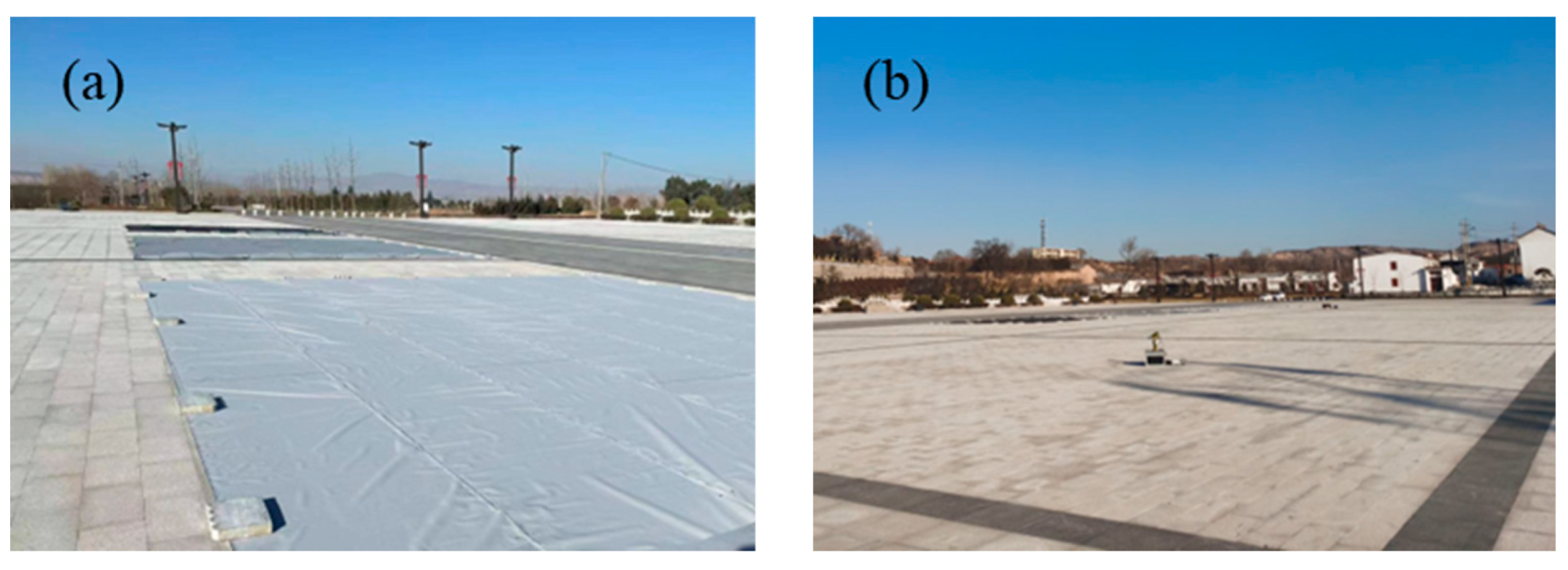





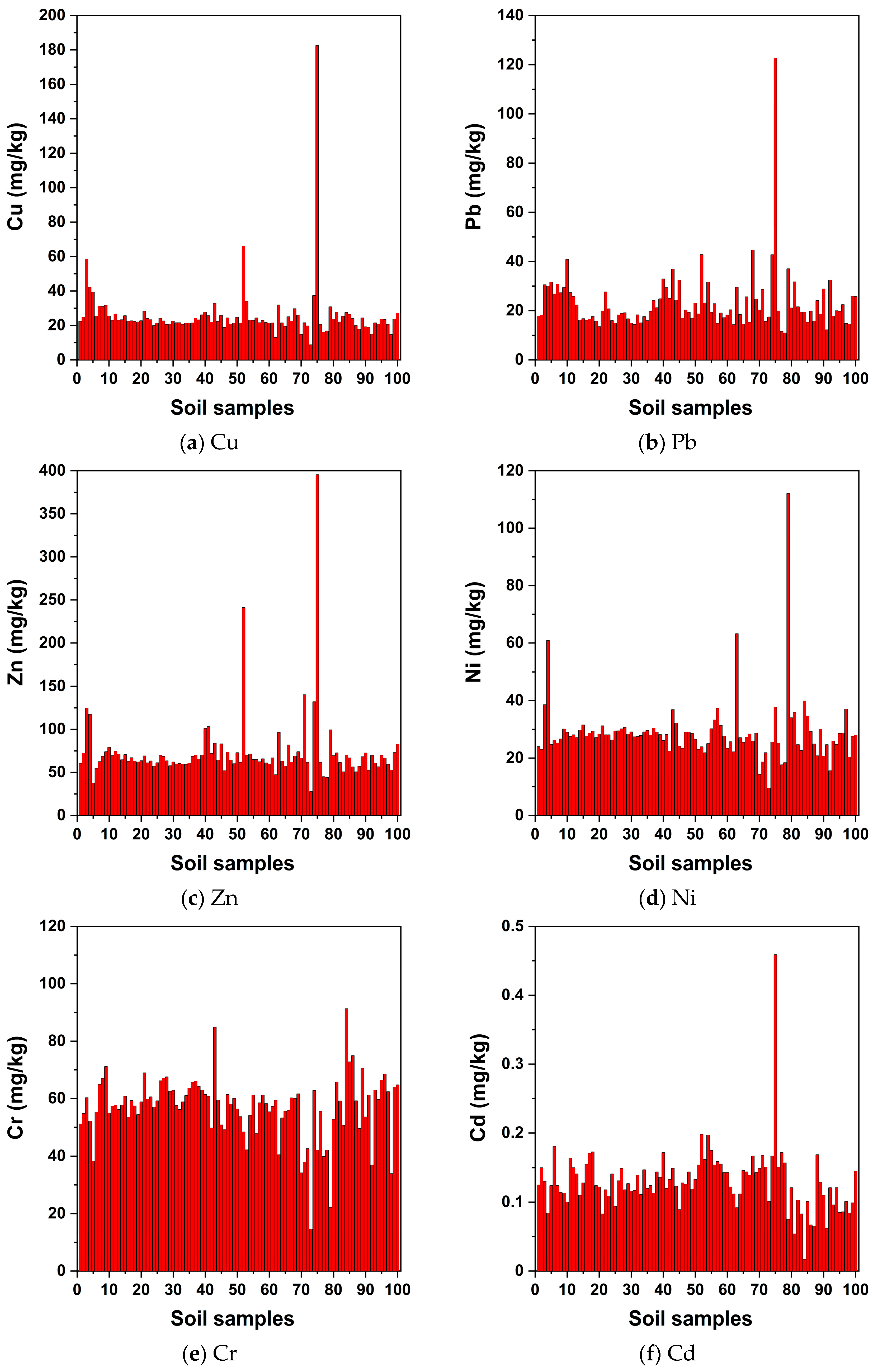
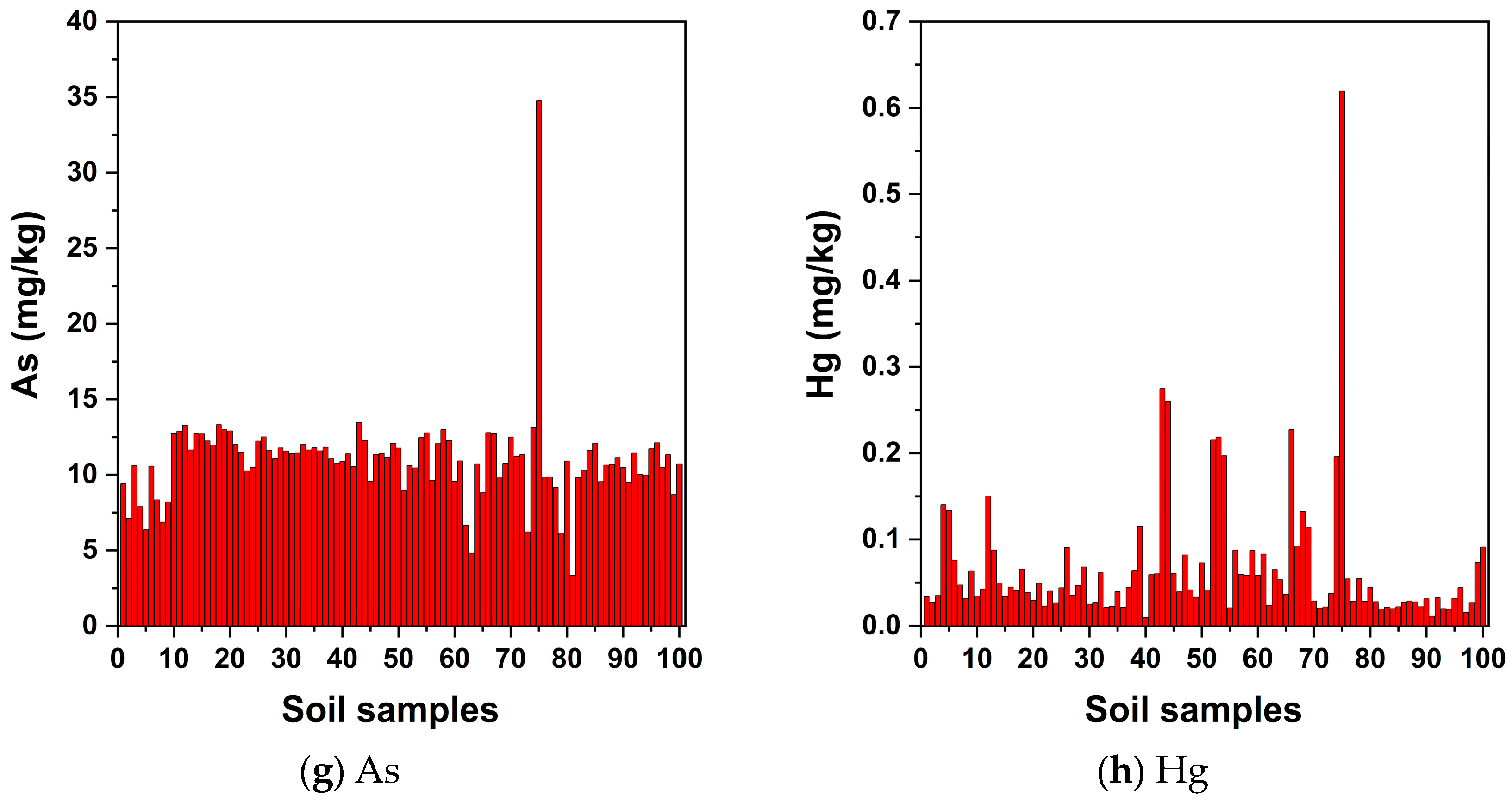

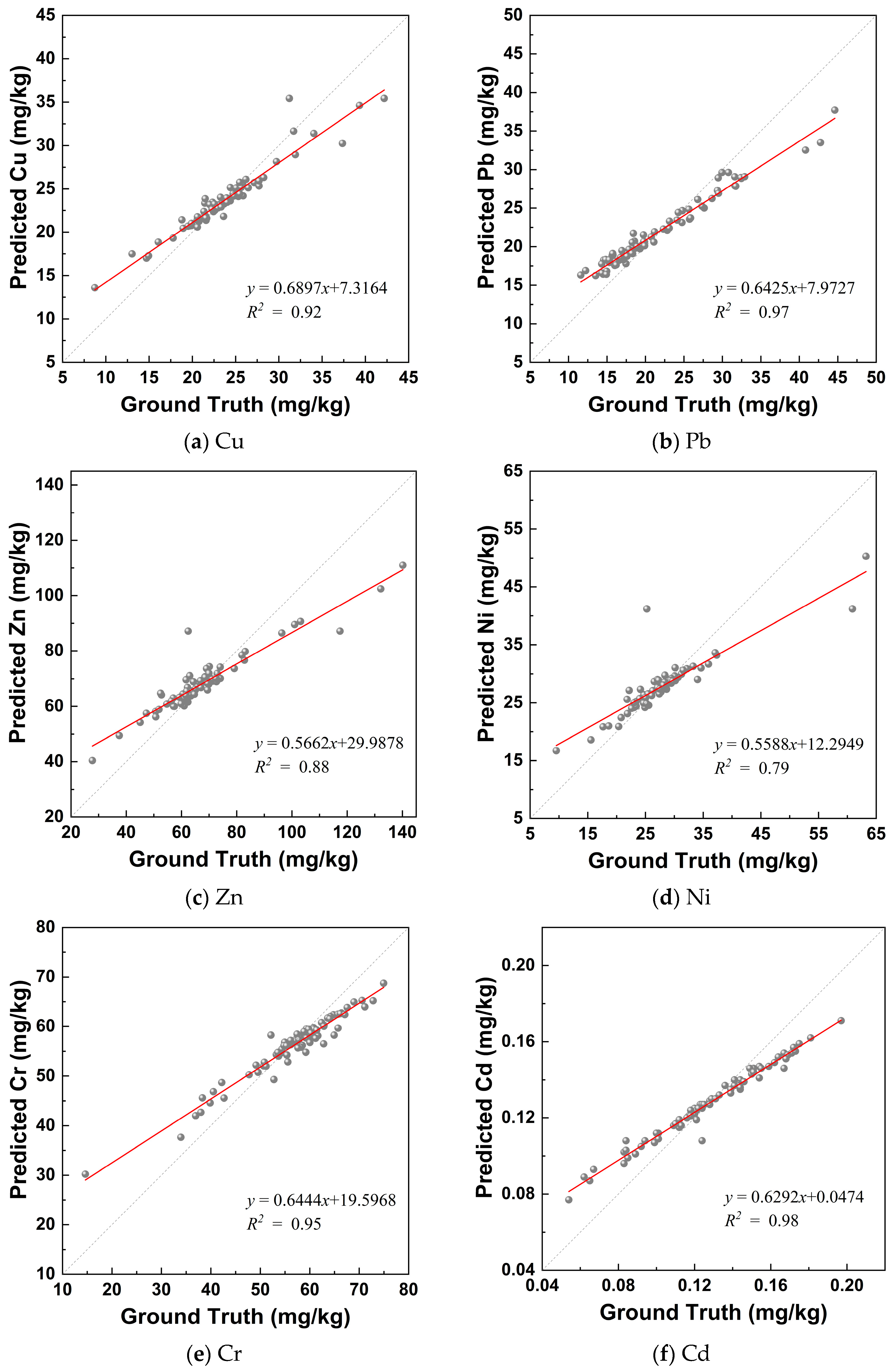

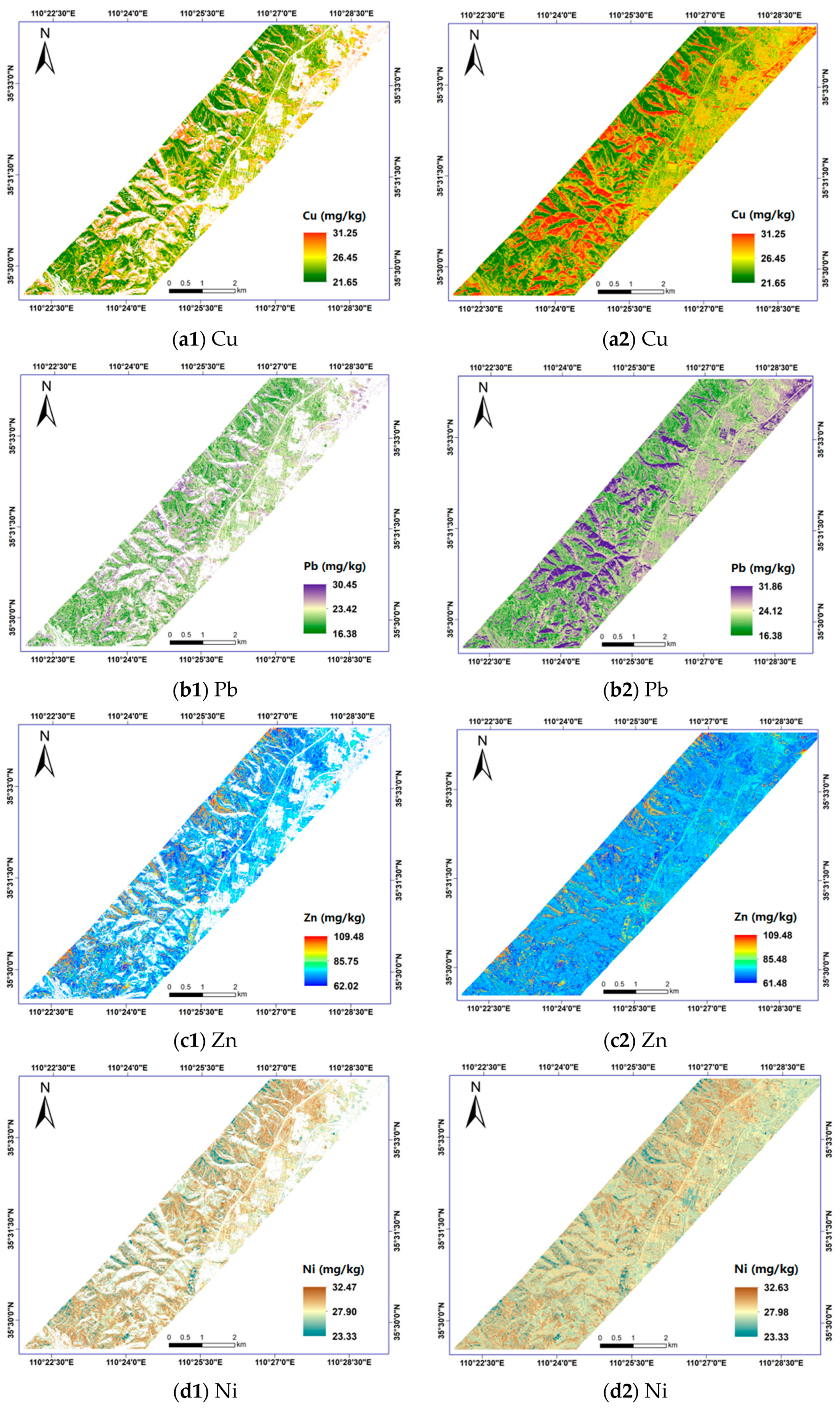

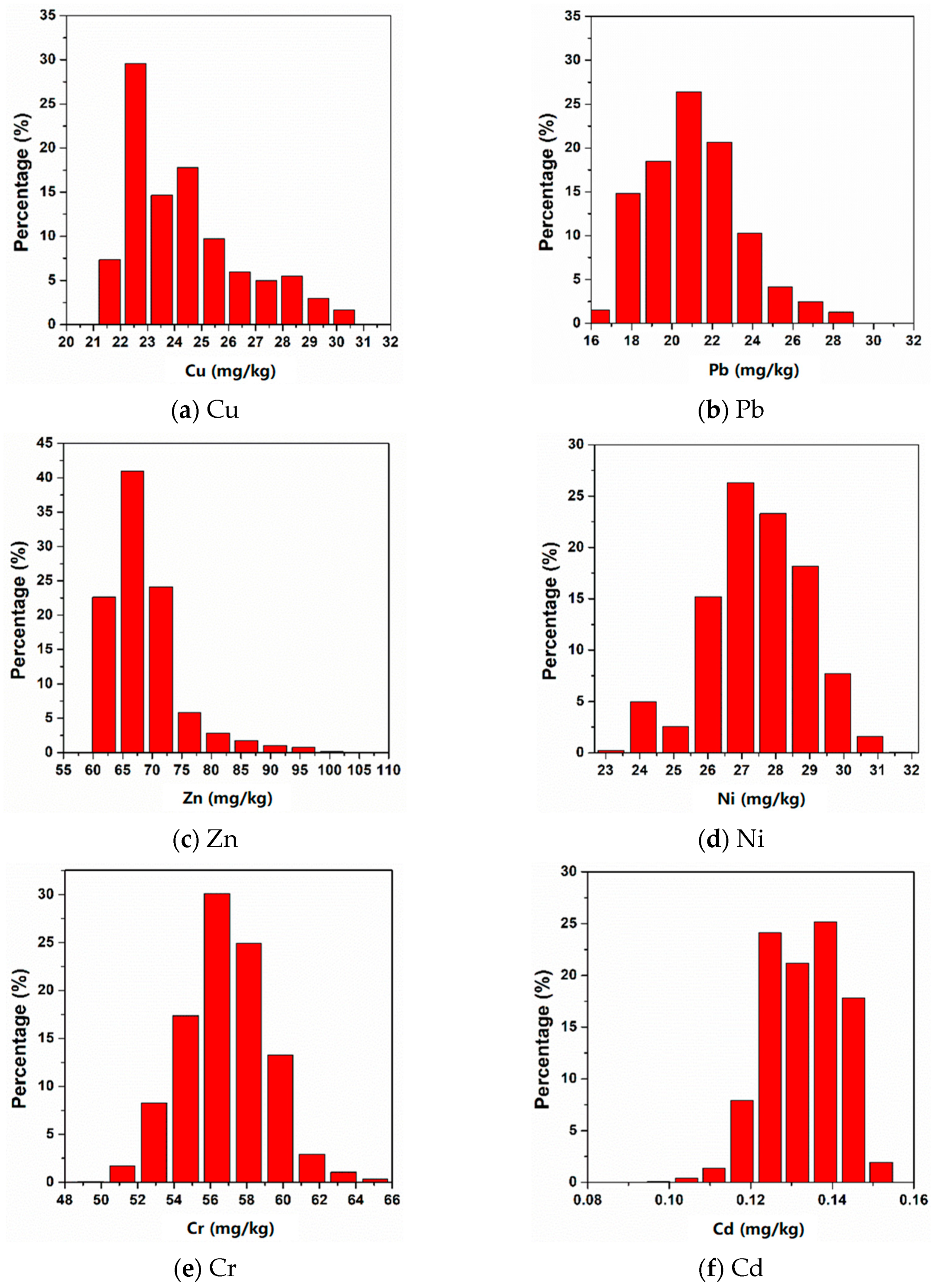

| Parameters | AMMIS |
|---|---|
| The total number of bands and wavelengths | 256 bands: 0.4–0.95 μm (VNIR channels) 512 bands: 0.95–2.5 μm (SWIR channels) 128 bands: 8–12.5 μm (TIR channels) |
| Spatial resolution | 0.5 m: 0.4–2.5 μm @ 2 km 2 m: 8–12.5 μm @ 2 km |
| Spectral resolution | 0.4–0.95 μm: 2.4 nm 0.95–2.5 μm: 3 nm 8–12.5 μm: 32 nm |
| IFOV (mrad) | 0.25 (VNIR sensor) 0.5 (SWIR sensor) 1 (TIR sensor) |
| FOV (°) | 40 |
| Scanning system | Push broom scanning |
| Input Data Subset | Description | Explanation |
|---|---|---|
| GS | Ground-based soil samples | |
| GCS | Ground-based cleaning soil samples | |
| AS | Airborne-based soil samples | |
| ACS | Airborne-based cleaning soil samples | |
| GRR | Ground-based resampling reflectance | |
| GER | Ground-based envelope reflectance | |
| AOR | Airborne-based original reflectance | |
| AER | Airborne-based envelope reflectance |
| Datasets | Methods | RMSE (mg/kg) | ||||||||
|---|---|---|---|---|---|---|---|---|---|---|
| Cu | Pb | Zn | Ni | Cr | Cd | As | Hg | |||
| GRR | GS | RF | 7.23 | 4.95 | 17.01 | 4.36 | 3.74 | 0.02 | 1.27 | 0.03 |
| SVM | 18.52 | 13.28 | 43.2 | 11.29 | 11.11 | 0.05 | 3.08 | 0.09 | ||
| PLS | 17.88 | 12.44 | 41.63 | 11.13 | 10.12 | 0.05 | 3.04 | 0.08 | ||
| GCS | RF | 2.84 | 2.53 | 9.89 | 2.73 | 3.96 | 0.01 | 0.69 | 0.02 | |
| SVM | 7.8 | 7.5 | 25.46 | 7.11 | 10.69 | 0.04 | 1.96 | 0.08 | ||
| PLS | 6.8 | 6.16 | 23.28 | 6.87 | 9.72 | 0.03 | 1.85 | 0.05 | ||
| GER | GS | RF | 7.42 | 4.84 | 17.12 | 4.58 | 3.92 | 0.02 | 1.23 | 0.03 |
| SVM | 18.79 | 13.45 | 43.62 | 11.56 | 11.33 | 0.05 | 3.18 | 0.1 | ||
| PLS | 18.17 | 12.08 | 41.54 | 11.33 | 10.43 | 0.05 | 3.13 | 0.08 | ||
| GCS | RF | 2.46 | 2.07 | 8.85 | 2.48 | 3.66 | 0.01 | 0.69 | 0.02 | |
| SVM | 7.8 | 7.6 | 25.52 | 7.13 | 10.67 | 0.04 | 1.88 | 0.08 | ||
| PLS | 6.97 | 5.92 | 23.65 | 6.72 | 9.86 | 0.03 | 1.78 | 0.05 | ||
| AOR | AS | RF | 7.8 | 5.38 | 18.8 | 6.02 | 4.88 | 0.02 | 1.25 | 0.04 |
| SVM | 20.75 | 14.74 | 49.23 | 12.8 | 11.74 | 0.05 | 3.4 | 0.1 | ||
| PLS | 19.76 | 13.53 | 45.78 | 12.11 | 11.33 | 0.05 | 3.32 | 0.08 | ||
| ACS | RF | 1.89 | 2.81 | 8.17 | 3.9 | 3.44 | 0.01 | 0.72 | 0.02 | |
| SVM | 5.05 | 7.73 | 17.35 | 7.18 | 8.28 | 0.03 | 1.98 | 0.07 | ||
| PLS | 4.13 | 6.84 | 16.27 | 6.95 | 7.97 | 0.03 | 1.9 | 0.05 | ||
| AER | AS | RF | 7.55 | 5.19 | 19.13 | 5.63 | 4.45 | 0.02 | 1.27 | 0.03 |
| SVM | 20.78 | 14.75 | 49.23 | 12.82 | 11.72 | 0.05 | 3.38 | 0.1 | ||
| PLS | 20.05 | 13.85 | 47.3 | 11.86 | 10.68 | 0.05 | 3.3 | 0.08 | ||
| ACS | RF | 1.87 | 2.74 | 8.47 | 3.92 | 3.17 | 0.01 | 0.69 | 0.02 | |
| SVM | 5.07 | 7.73 | 17.33 | 7.18 | 8.28 | 0.03 | 1.97 | 0.07 | ||
| PLS | 3.98 | 6.56 | 16.61 | 6.93 | 7.782 | 0.03 | 1.81 | 0.05 | ||
Disclaimer/Publisher’s Note: The statements, opinions and data contained in all publications are solely those of the individual author(s) and contributor(s) and not of MDPI and/or the editor(s). MDPI and/or the editor(s) disclaim responsibility for any injury to people or property resulting from any ideas, methods, instructions or products referred to in the content. |
© 2024 by the authors. Licensee MDPI, Basel, Switzerland. This article is an open access article distributed under the terms and conditions of the Creative Commons Attribution (CC BY) license (https://creativecommons.org/licenses/by/4.0/).
Share and Cite
Jiang, C.; Ren, H.; Wang, Z.; Zeng, H.; Teng, Y.; Zhang, H.; Liu, X.; Jin, D.; Wang, M.; Liu, R.; et al. Estimation of Soil-Related Parameters Using Airborne-Based Hyperspectral Imagery and Ground Data in the Fenwei Plain, China. Remote Sens. 2024, 16, 1129. https://doi.org/10.3390/rs16071129
Jiang C, Ren H, Wang Z, Zeng H, Teng Y, Zhang H, Liu X, Jin D, Wang M, Liu R, et al. Estimation of Soil-Related Parameters Using Airborne-Based Hyperspectral Imagery and Ground Data in the Fenwei Plain, China. Remote Sensing. 2024; 16(7):1129. https://doi.org/10.3390/rs16071129
Chicago/Turabian StyleJiang, Chenchen, Huazhong Ren, Zian Wang, Hui Zeng, Yuanjian Teng, Hongqin Zhang, Xixuan Liu, Dingjian Jin, Mengran Wang, Rongyuan Liu, and et al. 2024. "Estimation of Soil-Related Parameters Using Airborne-Based Hyperspectral Imagery and Ground Data in the Fenwei Plain, China" Remote Sensing 16, no. 7: 1129. https://doi.org/10.3390/rs16071129
APA StyleJiang, C., Ren, H., Wang, Z., Zeng, H., Teng, Y., Zhang, H., Liu, X., Jin, D., Wang, M., Liu, R., Wang, B., & Zhu, J. (2024). Estimation of Soil-Related Parameters Using Airborne-Based Hyperspectral Imagery and Ground Data in the Fenwei Plain, China. Remote Sensing, 16(7), 1129. https://doi.org/10.3390/rs16071129







